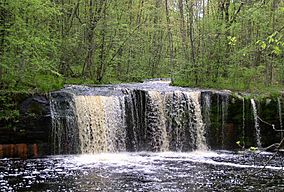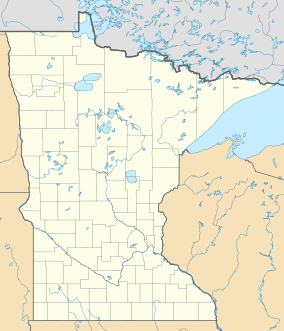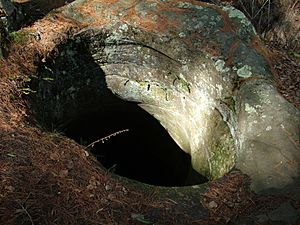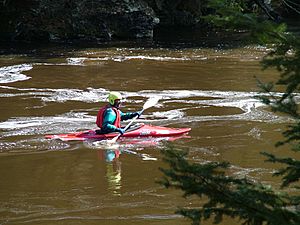Banning State Park facts for kids
Quick facts for kids Banning State Park |
|
|---|---|

Wolf Creek Falls
|
|
| Location | Pine, Minnesota, United States |
| Area | 6,237 acres (25.24 km2) |
| Elevation | 1,122 ft (342 m) |
| Established | 1963 |
| Governing body | Minnesota Department of Natural Resources |
Banning State Park is an awesome state park in Minnesota, USA. It stretches for about 10 miles (16 km) along the Kettle River. You can find it near the town of Sandstone in Pine County.
The most exciting part of the park is a 1.5 miles (2.4 km) stretch of super fast rapids. Some of these rapids are so wild, they're called "Class IV." Brave kayakers and canoeists love to challenge these rapids every spring. They even have cool names like Blueberry Slide and Hell's Gate! Lots of people come to watch them.
If you prefer to stay on land, you can hike along the Kettle River. It's Minnesota's first "Wild and Scenic River." You'll see amazing sandstone rock formations and huge holes in the rock. These holes were carved by the river itself. You can also explore the remains of an old stone quarry. Other cool spots include Wolf Creek Falls and Robinson Ice Cave. The park is super easy to get to, right off Interstate 35.
Contents
Exploring Banning State Park's Nature
Rock Formations and River Power
Banning State Park sits in a shallow valley made by the Kettle River. The top layer of soil is very thin here. In the middle of the park, the river has cut deep into the rock. It goes through ancient sandstone and into the solid bedrock. This has created a deep gorge that can be up to 40 feet (12 m) tall at a spot called Hell's Gate. This is also where you find the 1.5 miles (2.4 km) of exciting rapids.
The park is famous for its many "glacial potholes." These are smooth, round holes drilled into the rock. They formed a long, long time ago when the last ice age ended. Melting ice made the river huge and powerful. Swirling water created strong eddies that spun rocks and debris around. This literally drilled holes into the riverbed! In the northern part of the park, you can see "Log Creek Arches." These are potholes where the bottom has worn away on one side.
Robinson Ice Cave: A Bat's Home
Robinson Ice Cave is a 200-foot (61 m) deep cave hidden in the bluffs. It's located between Wolf Creek Falls and Sandstone. This cave is not open to the public. Its entrance is gated to protect the bats that live there. Many bats, like little brown bats and big brown bats, use the cave for hibernating in winter. In colder months, large ice formations, called stalagmites, often grow on the cave floor. But it's not a true ice cave because the ice doesn't stay there all year.
Away from the river, the land is mostly flat or gently rolling. This area was shaped by glaciers.
Plants and Animals of the Park
The forests in Banning State Park are still growing back. They were heavily logged and affected by forest fires in the 1800s. Today, you'll see many birch and aspen trees. Originally, the area had more Norway and eastern white pines.
The park is a great place for wildlife watching! Over 184 types of birds have been seen here, including ruffed grouse. You might also spot common mammals like white-tailed deer, black bear, fox, and raccoon. There are 17 kinds of reptiles and amphibians, and 34 different types of mammals living in the park.
A Look Back: History of Banning State Park
The Quarry Town of Banning
The pink sandstone found in the river valley was perfect for building. So, in 1892, people started digging it out. A railroad track was even built to carry the stone away. The terrible Great Hinckley Fire in 1894 caused a setback. But the quarry quickly recovered. Two years later, a town grew up right next to the quarry. It was named Banning, after the railroad president. The railroad helped ship the stone to cities like St. Paul and Duluth.
By 1905, the quarrying boom was over. Most of the good sandstone that was easy to get was gone. Also, architects started using structural steel more than stone for buildings. An asphalt company stayed open until 1912. When it closed, the town of Banning became a ghost town. The railroad tracks were removed a few years later.
From Ghost Town to State Park
In 1959, a local history group thought the Banning ghost town would make a great historical site. But everyone soon realized how beautiful the whole area was. So, the idea changed to creating a new state park. A law was passed in 1963 to make it a park. However, it took until 1967 for the state to buy enough land to build things like campgrounds. A wilder northern section was added in 1986.
In 1995, a dam at the park's southern end was removed. This brought back a beautiful waterfall and another set of rapids. It's interesting that the remains of the old town, which helped create the park, are now completely gone!
Fun Things to Do at Banning State Park
Water Adventures
The Kettle River is a top spot for whitewater paddling. You can go rafting, canoeing, and kayaking here. The park has two places where you can carry your boat to the water. There are also two boat ramps. Much of the river is "Class I," which means it's pretty calm. But you'll need to carry your boat around the big rapids. Fishing is also popular on the Kettle River. It's even known for producing state-record sturgeon fish!
Camping and Trails
Banning State Park has a campground where you can drive right up to your site. There are 33 sites, and 11 of them have electricity. There's also a cozy camper cabin and showers. If you're paddling, there are four special campsites along the river just for canoeists. The park staff also helps manage another campground nearby in General C. C. Andrews State Forest. That one has 38 drive-in sites and a group tent camp.
The park has about 17 miles (27 km) of hiking trails. There's even a paved bicycling path that connects to the Willard Munger State Trail. In winter, 11 miles (18 km) of trails are prepared for cross-country skiing. About 6 miles (9.7 km) are open for snowmobiling. You can go snowshoeing anywhere in the park, except on the groomed trails.
Images for kids






